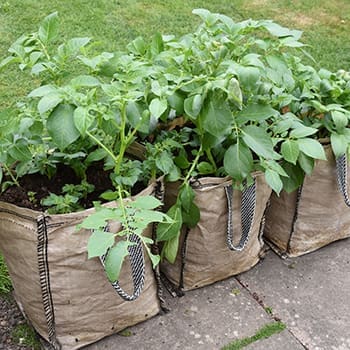As a homesteader, I find joy in being self-sufficient and growing my own produce in a small garden. While I may not have truckloads of produce, I believe in sharing the easiest and less complicated methods to cultivate salad greens, tubers, fruits, and vegetables.
One of my favorite shortcuts to avoid backbreaking tasks is building a potato tower to grow sweet potatoes. In this guide, I’ll provide technical instructions on how to construct and benefit from a potato tower on your homestead.
What Is A Potato Tower?
A potato tower is a creative and space-efficient gardening method used to grow potatoes. It involves constructing a vertical structure, typically using chicken mesh or similar materials, and filling it with a mixture of compost and organic manure.
Sweet potato cuttings or potato seeds are planted within the tower, allowing the plants to grow upward instead of spreading across the ground. This ingenious approach maximizes growing space, facilitates easy harvesting, and provides better air circulation and drainage for healthier plants.
The potato tower is a popular choice for home gardeners and homesteaders looking to produce a bountiful harvest of nutritious potatoes in a small footprint.
Growing Sweet Potatoes
Sweet potatoes are not only delicious but also rich in minerals, antioxidants, vitamins, and fiber. They come in various colors like white, purple, and orange. Personally, I prefer the purple variety due to my love for that color.
Why Sweet Potatoes In A Potato Tower?
Nutrient-Rich Yield: Sweet potatoes are a nutritional powerhouse, packed with vitamins, minerals, and fiber. Growing them in a tower ensures a bountiful harvest of delicious and nutritious tubers.
Space-Saving: Potato towers optimize vertical space, making them ideal for smaller gardens or homesteads with limited land.
Soil Health: Sweet potatoes are excellent for soil improvement. They thrive in well-draining, loose soil, and their vigorous growth helps break up compacted earth.
Caring For Your Sweet Potato Tower
Planting: Begin by rooting sweet potato cuttings in water. Once they develop roots, plant them in a mixture of compost and organic manure within the tower.
Watering: Sweet potatoes prefer consistent moisture. Water them regularly, but avoid overwatering to prevent rot. The tower’s design allows for efficient drainage, reducing the risk of waterlogged soil.
Fertilizing: Sweet potatoes benefit from nutrient-rich soil. Adding compost and organic manure during planting provides them with essential nutrients.
Sunlight Requirements
Sweet potatoes are sun-loving plants. They require at least 6 to 8 hours of sunlight daily for optimal growth. Position your potato tower in a sunny location to ensure robust and productive plants.
Pests And Diseases
Pests: Sweet potatoes can attract certain pests like sweet potato weevils, aphids, and whiteflies. To mitigate infestations, practice companion planting with pest-repelling herbs like mint or basil. Regularly inspect the plants for signs of pests and apply organic pest control measures as needed.
Diseases: Sweet potatoes can be vulnerable to fungal diseases such as powdery mildew and black rot. Ensure good air circulation around the plants and avoid overwatering to prevent these issues. Additionally, practice crop rotation to reduce disease buildup in the soil.
Building The Potato Tower
It was super easy to build my potato tower. The materials are cheap or maybe you already have them in your homestead and there are only a few instructions to follow. To construct your sweet potato tower, follow these steps:
Gather your materials: You’ll need chicken coop mesh, a clay pot, compost, and dried cow manure (or another type of organic manure you typically use for your edible items).
Form the mesh cylinder: Wind the chicken coop mesh into a cylindrical shape and secure it with a flexible piece of wire. This will serve as the structure for your potato tower.
Secure the bottom: Push the mesh down into the clay pot so that it fits snugly. This ensures that the growing tubers will be supported and won’t touch the ground, preventing slugs and snails from feasting on them.
Add compost and manure: Fill the tower with a mixture of compost and dried cow manure. Organic manure enriches the soil and aids in the healthy growth of sweet potatoes, resulting in longer and larger tubers.
Plant the sweet potato cuttings: Take cuttings of sweet potato stalks, and immerse them in water until they develop roots. Then, plant them in the compost and manure mixture within the tower.
Other Methods To Grow Your Potatoes
Potatoes are a versatile and nutritious staple in many diets, making them a popular choice for home gardeners and homesteaders.
While traditional methods of growing potatoes in the ground can be effective, there are several ingenious techniques that have emerged to maximize space, improve yields, and make cultivation more accessible.
Among these innovative approaches, the potato tower stands out as an excellent and practical solution. Let’s explore some of the ingenious methods and why the potato tower takes the lead.
Traditional In-Ground Planting
The most common method of growing potatoes involves planting them directly in the ground. While this approach works well for many gardeners, it requires ample space and can be labor-intensive during harvesting. However, it remains a reliable option for those with enough land and the willingness to put in the effort.
Raised Bed Potato Gardening
Raised beds are another ingenious way to grow potatoes. By elevating the planting area, gardeners can improve soil drainage and create a controlled environment for the tubers.
Raised beds also help prevent soil compaction, making it easier for the potatoes to develop without obstruction.
Potato Grow Bags or Containers
Potato grow bags and containers have gained popularity for their adaptability in various settings, including small gardens, balconies, and patios.
These bags allow for easy mobility, better soil aeration, and effective drainage. However, the limited soil volume in containers can sometimes lead to smaller yields compared to other methods.
Straw Bale Potato Gardening
Straw bale gardening is a unique technique where potatoes are planted directly into decomposing straw bales.
As the straw breaks down, it provides a nutrient-rich environment for the tubers to grow. This method reduces the need for digging and promotes good aeration for the roots.
Hilled Rows
Hilling is a traditional practice where the soil is mounded around the potato plants as they grow. This encourages the development of additional tubers along the buried stems.
While hilling can be effective, it requires regular maintenance and can become cumbersome for larger potato plots.
Why The Potato Tower Stands Out
Among these ingenious methods, the potato tower offers several distinct advantages that make it the best choice for many gardeners and homesteaders:
Space Efficiency: The potato tower maximizes vertical space, making it suitable for gardens with limited land or for those who want to grow potatoes on patios and balconies. It allows for significant potato production in a small footprint.
Easy Harvesting: Harvesting potatoes from a tower is remarkably simple. Instead of digging into the ground, you can lift the tower or remove sections to access the tubers easily, saving time and effort.
Improved Air Circulation: The tower design promotes better air circulation around the plants, reducing the risk of fungal diseases and creating a healthier growing environment.
Effective Drainage: The structure of the potato tower ensures proper drainage, preventing waterlogged soil and minimizing the risk of root rot.
Cost-Effective: Building a potato tower can be done using affordable and readily available materials like chicken mesh, making it a budget-friendly gardening solution.
Final Thoughts
As a homesteader, I’ve found the potato tower to be a valuable addition to my garden. A potato tower is an excellent solution for homesteaders seeking a space-efficient and productive gardening method.
While they may face some pests and diseases, vigilant monitoring and natural pest control measures can help ensure a successful and rewarding harvest.
Happy gardening!
You may also like:
The Bunker Food You Need To Have Right Now (Video)
10 Best Medicinal Plants Every Homesteader Should Grow
How To Start An Easy Vegetable Container Garden
If You See These Eggs In Your Backyard, Burn Them Immediately














where do I go to download the books that came with my purchase?
Hi Edward,
Thank you for your message.
You will receive an email from support@selfsufficientbackyard.com with details about your order.
Let us know if you need further assistance.